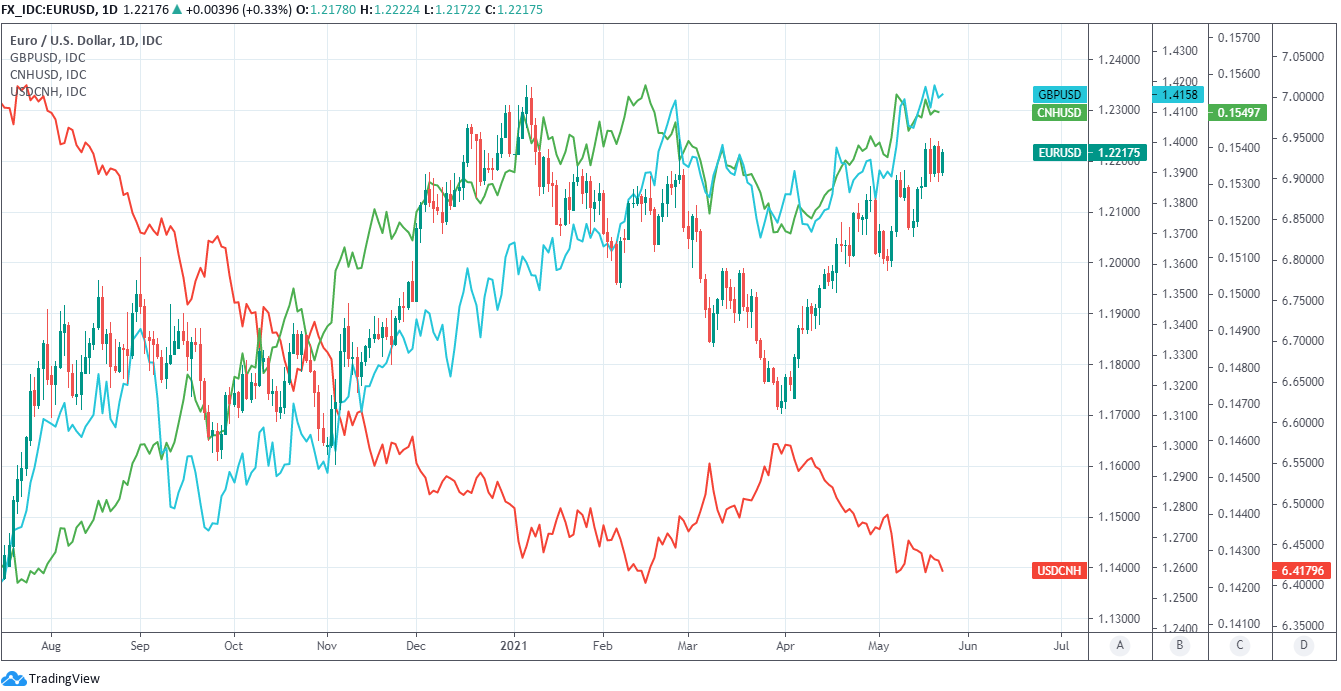Euro-Dollar Week Ahead Forecast: Striving for 2021 Highs
- Written by: Gary Howes
- EUR bucks USD trend with broad advance to open week
- 2021 highs in contention for EUR/USD once past 1.2243
- Further gains likely amid any USD/CNH push below 6.40

Image © Adobe Images
- EUR/USD reference rates at publication:
- Spot: 1.2222
- Bank transfers (indicative guide): 1.1790-1.1880
- Money transfer specialist rates (indicative): 1.2130-1.2160
- More information on securing specialist rates, here
- Set up an exchange rate alert, here
The Euro-to-Dollar exchange rate entered the new week with a rally that could quickly see 2021 highs come into contention if the single currency succeeds in getting past the nearby 1.2240 level over the coming days, with upside risks if any commodity-inspired appreciation of the Renminbi materialises.
Europe’s single currency emerged resurgent on Monday from late in the day declines seen last Friday when European Central Bank (ECB) President Christine Lagarde gave short shrift to suggestions that Frankfurt could look to taper its pandemic-inspired quantitative easing programme any time soon.
Disappointment in some parts over the bank’s caution added to last minute losses for Europe’s unified unit, although the Euro had dusted itself off in earnest by Monday when it was seen rising against all major counterparts in spite of further strength in U.S. exchange rates.
“USD had a knee jerk upside move against most major currencies early during the European session. There were no fundamental triggers behind this brief move. In our view, USD will remain under downside pressure because of the FOMC’s ultra‑dovish guidance and improving global economic activity,” says Elias Haddad, a strategist at Commonwealth Bank of Australia.
Secure a retail exchange rate that is between 3-5% stronger than offered by leading banks, learn more.
The Euro-Dollar rate was back above 1.22 and attempting to overcome nearby resistance between 1.2240 and 1.2250, which is the last technical impediment to a return to 2021 highs up near 1.2350 that were last seen in the earliest days of January.
“Above 1.2243 targets 1.2349, the 2021 high. Our longer term target is 1.2556/1.2619, the 2018 high, the 200 month moving average and the 55-quarter ma,” says Karen Jones, head of technical analysis for currencies, commodities and bonds at Commerzbank.
The Euro’s resurgence comes as continental economies reopen from the latest coronavirus-inspired closures, and has coincided with a rally by Central and Eastern European (CEE) currencies as well as what had thus-far been a period of weakness for the Dollar.
{wbamp-hide start} {wbamp-hide end}{wbamp-show start}{wbamp-show end}
“In practical terms, EUR/USD 1.2250 is the key level that needs to break for dollar bears to be encouraged. 1.2150 is important short-term support and a break of 1.20 would give dollar bulls real heart,” says Kit Juckes, chief FX strategist at Societe Generale.
“If we break the upside, I think there's a good chance of breaking USD/CAD [1.20], GBP/USD 1.42, and it's possible that AUD/USD makes a move towards 0.80. Clear hawkish signals from the National Bank of Hungary are the clearest potential catalyst,” Juckes adds.
Juckes and the Societe Generale team note that robust market appetite for the Hungarian Forint and its CEE counterparts is indirectly supportive of the Euro-Dollar rate and have flagged Tuesday’s 13:00 interest rate decision from the National Bank of Hungary as key to whether the Euro is able to break higher over the coming days.
Above: EUR/USD shown at daily intervals alongside GBP/USD.
The European economic calendar is devoid of major events this week, leaving the Euro to take its cues from international factors like U.S. economic data and the Dollar’s response to it, although a more important indicator of the Euro-Dollar outlook would be price action in Chinese exchange rates and most notably USD/CNH.
“If we do see an independent move lower in USD/CNH as the market does the PBoC’s bidding of delivering a stronger currency to fight import prices – stable correlations suggest EUR/USD would be rallying at the same time. Such a move would support our end year EUR/USD forecast of 1.28,” says Chris Turner, global head of markets and regional head of research at ING.
China made headlines over the weekend when Vice President Liu Guoqiang of the People's Bank of China (PBoC) said the bank will “maintain the basic stability of the RMB exchange rate at a reasonable and balanced level,” which many in the market took to mean the PBoC would be unlikely to adopt the proposals made by Lu Jinzhong, head of research at the Shanghai branch of the PBoC, in one of the bank’s magazines last week.
Jinzhong had suggested in a since-deleted article that the PBoC should “appropriately appreciate the RMB” via the USD/CNH exchange rate in order to offset double-digit percentage gains in Dollar-denominated commodity prices which have raised costs and squeezed margins for many companies.
Above: ING Group graph showing various currencies’ correlations with the Renminbi.
Rising commodity prices lifted China’s Producer Price Index by 6.8% in April and by an average of 3.3% in each month of 2021, which are large increases that would require substantial declines in USD/CNH or gains in the Renminbi in order for them to be offset.
Offsetting even only a 3.3% increase in prices by strengthening the Dollar-facing Renminbi exchange rate would require USD/CNH to fall to 6.22 and its lowest level since early 2018, which would be an upside risk to the Euro owing at the very least to its positive correlation with the Renminbi.
“Away from the US calendar, the market will keep close watch on volatility in crypto-currencies and tech stocks as well as developments in the Renminbi. Any signs of independent Renminbi strength could lend weight to the notion that the PBOC wants a stronger currency to insulate against imported commodity price rises. This would be bearish for the dollar in our opinion,” says ING’s Turner.
“Let’s see whether USD/CNY can break under the 6.40/41 area over coming weeks (we do in general like a soft dollar environment this summer) and in general, broad trends in USD/Asia – particularly in USD/CNY – do tend to support the overall USD trend,” Turner adds.
Above: EUR/USD shown alongside CNH/USD (green), GBP/USD (blue) and USD/CNH (red).







